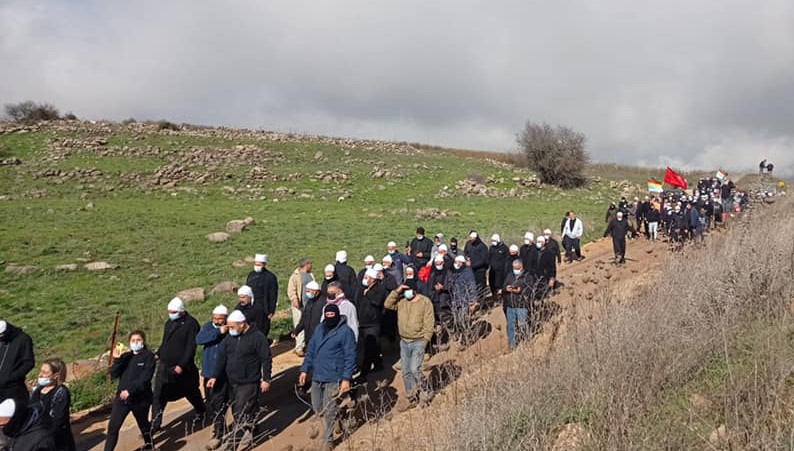Twenty demonstrators and four police officers were injured in clashes Wednesday morning, December 9, in the northern occupied Golan Heights, as hundreds of residents protested the construction of wind turbines on agricultural land that belongs to four Syrian Druze villages in the area.

Syrian Druze marched in protest against the building of wind turbines on their agricultural lands in the occupied Golan Heights by an Israeli energy company, Wednesday, December 9, 2020. (Photo: Al Marsad)
The Al-Sham (Syria) Centre in Majdal Shams had called on the Syrian residents still residing in the Golan, predominantly Arab-Druze, to participate in a general strike on Wednesday, including closing shops and schools, to “protect” the land and “defend us.” On the day of the strike, a clash erupted in an orchard, where eight Druze were arrested after Israeli forces began firing tear gas canisters and rubber-coated bullets.
The strike had been called two days earlier, on Monday, December 7, after Israeli forces restricted access by residents to their lands and crops and blocked the main entrances to the four Syrian Druze villages still populated in the occupied northern Golan: Majdal Shams, Sahita, Baqatha and Masada.
Before the 1967 war, there war some 170 Syrian towns, villages and hamlets in the Golan Heights with a total population then estimated at between 130,000 and 145,000, including 17,000 Palestinian refugees registered with UNRWA. A large proportion of the Syrian citizens living in the Golan until 1967 were descendants of refugees from the Caucasus (Circassians) encouraged to settle there by the Ottomans after the Russo-Turkish War of 1887-1888. Following Israel’s occupation of the 1,800 square kilometer (690 square mile) plateau, the overwhelming majority of the Syrian population was uprooted, and only about 7,000 residents remained in the four Druze villages mentioned above. In the wake of the June 1967 war, Israel razed 165 depopulated villages in the Golan and distributed their lands among the various Jewish settlements it established there, including Israeli military bases. Today, Syrian citizens still residing in the Golan number around 24,000 while Israeli settlers living in 36 Jewish settlements are estimated at about 22,000.
According to Israeli sources, the Israeli energy firm Energix Renewable Energy “legally purchased the right to use the land from the owners and intends to develop a 32-turbine wind farm.” However, the company obtained approval from the Israeli government and not the local population living under Israeli occupation. In a joint statement, Al-Marsad – The Arab Human Rights Center in the Golan Heights and the Association for Civil Rights in Israel (ACRI) condemned the bullying and aggressive behavior of the Israeli police and called for the immediate withdrawal of police forces from roadblocks across the Syrians’ agricultural lands. Based on information received by Al-Marsad to date, there has been no judicial order allowing for Energix to begin advancing its project, and thus its actions, and the actions of the Israeli police, are unlawful. Energix is owned (72%) by Alony Hetz Properties and Investments Ltd. and is one of the largest real-estate investment groups in Israel.
According to Hadash MK Jaber Asakli (Joint List) the Israeli police, in concert with Energix and through force, “are imposing baseless restrictions on and harassing the Syrian-Druze population, restricting access to property and freedom of movement for what may be several days. The police’s imposition of these restrictions constitutes collective punishment against Syrians in the occupied Golan.”
Israel imposed its laws, jurisdiction and administration on the occupied Golan Heights on December 14,1981 when the Knesset passed legislation to this effect. While this Golan Heights Law effectively annexed the territory to Israel, it did not explicitly spell out a formal annexation. Nevertheless, the UN Security Council passed resolution 497 three days after the Knesset’s action, declaring this step “null and void and without international legal effect.” However, in 2019, US President Donald Trump recognized the Golan Heights as part of Israel. According to international law, Israel is still an occupying power.
Related:
- Syrian Druze Hold Strike against Greenwashing of Golan Occupation
- Download the publication (in English) by Marsad – The Arab Human Rights Centre in Golan Heights:
Windfall – The Exploitation of Wind Energy in the Occupied Syrian Golan


